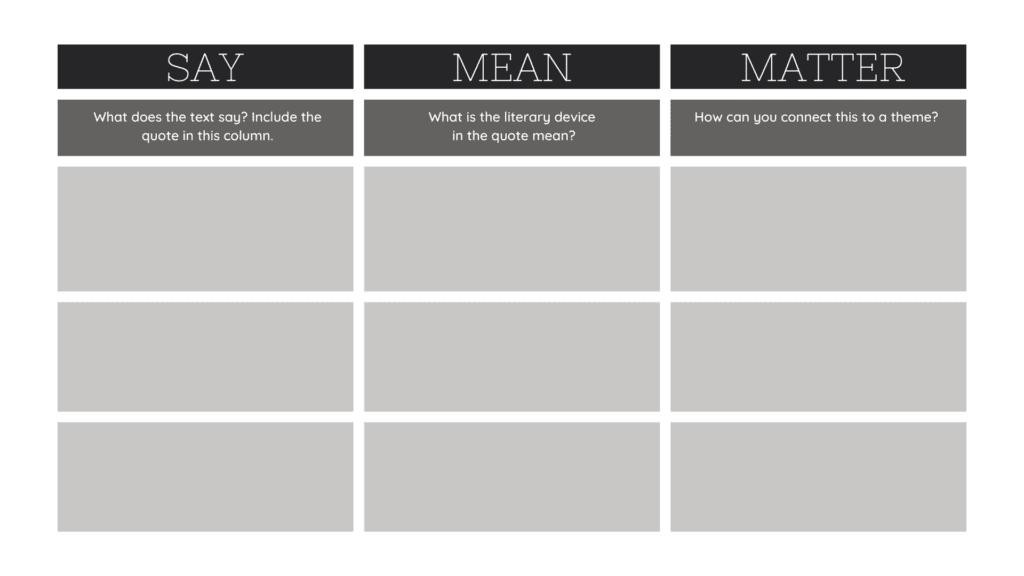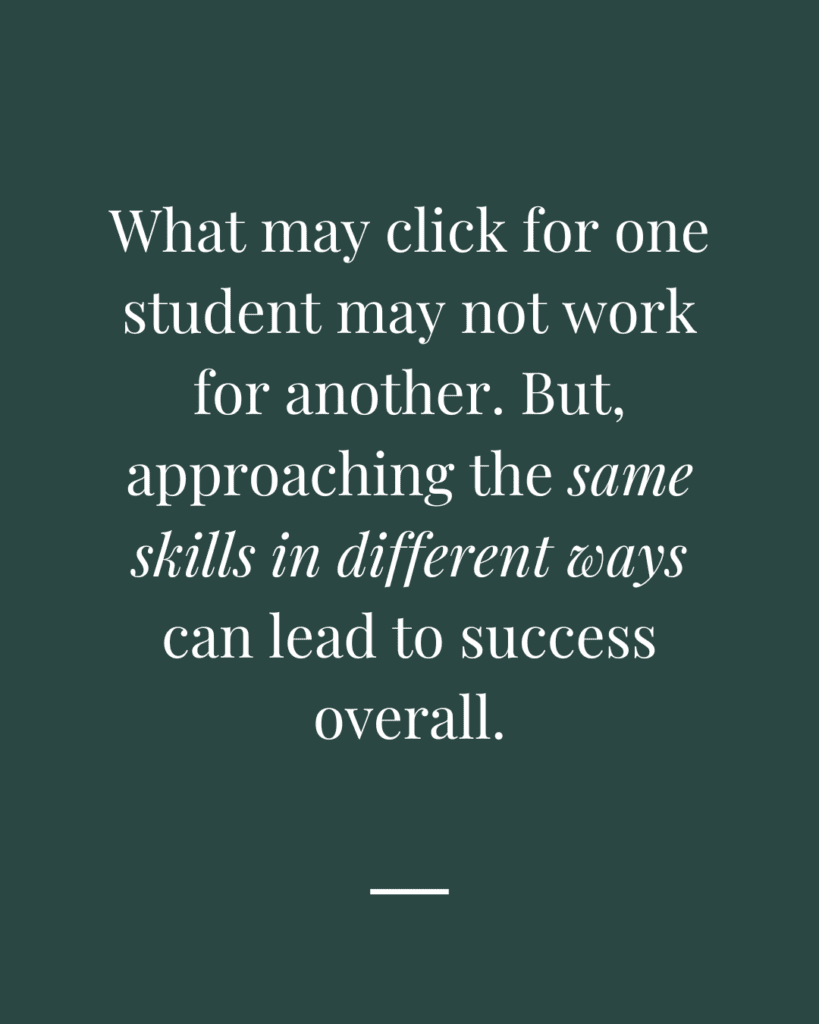As a high school English teacher, literary analysis is a central feature of much of the curriculum. Literary analysis is important in deepening students’ understanding of literature and other academic disciplines, but this key skill is also important in helping students develop critical thinking to apply to other areas of their life in and out of school.
One of my core teaching memories was when I saw it click for my student that everything that we had been doing in class was a variation of analysis. His exact words were, “I know this is a new assignment, but this feels really easy – like I’ve done this before.” When I tracked back over the past several months of assignments to explain to him that we have been working on the same skill in different ways he was mind blown. The takeaway that I always try to recreate is giving students enough practice so that it feels easy, but in different ways so it doesn’t feel stale. Incorporating different approaches to literary analysis engages students and expands their perspectives.

Table of Contents
Introducing Literary Analysis to Students
There are a few roadblocks that students have to successful literary analysis.
- Students cannot recognize and identify literary devices.
- Students have trouble explaining the literary device (for instance, explaining that the metaphor is comparing x to y).
- Students have trouble moving beyond #2 to explain the author’s purpose and literary effect.
In my classroom, I will have students stopped at all of these roadblocks, in addition to having students that effectively and artistically discuss #3. But, in order to tease out where students are and to effectively move students on this continuum, I use a few assignments that have become staples in my classroom. What I have found is a key to moving students from one stage to another is by asking students to do all components, one through three, but isolating each part in the assignment.
Say Mean Matter Framework
The simplest way to do this is through a Say Mean Matter chart. This strategy comes from Kelly Gallagher in Deeper Reading. While Say Mean Matter is a relatively common strategy among teachers, as far as I can tell, Gallagher suggests a Say/Mean chart and then later pushing students to discuss the Matter portion. Teachers can use the say and mean columns in various ways to aid comprehension. This is the way it works: in the “Say” column, students write quotes or plot points and in the “Mean” column they write the inferences that they make based on the “Say.” They later use both columns to discuss why the text matters. What he means by that is how comprehension and investigation of the text connects to our understanding of our modern world.
Using Gallagher’s framework, I suggest a simpler way to present this:

- Say: This is the actual text – a quote. If I were asking a student orally what a book says I would want them to find a place in the text and read it to me.
- Mean: I also want for students to make inferences, but I find that it helps students to have a more concrete approach, so I tell them to explain the literary devices in the text. Depending on the student or level, I might ask them to interpret connotation and denotation here, or perhaps analyze with a literary criticism lens. I give students these parameters in the Mean column.
- Matter: When I look at what Gallagher is outlining, it looks like theme to me. For me, theme is a sentence, not a word, so they are getting to what the author wants us to consider or come to understand about a topic that could be applied to life today.
Enhancing Comprehension and Interpretation
I find that these cues help students to move through all of the stages I outlined above. If a student struggles, it is clear at which point they hit a roadblock. A common issue is that they put what I would consider “Mean” in the “Matter” column. But, using this strategy of separating “Mean” and “Matter,” through giving comments for students to move what they have written in the “Matter” column to the “Mean” column, students then clearly understand what should be in the “Mean” column.
Varying Literary Analysis Activities
Once we have an initial attempt (or set of attempts) with Say, Mean, Matter, I like to give students another angle by presenting the same skills in a more visual way. At some point, I heard what I thought was a very interesting way to present analysis, as a “bounce” – what the reader can say about the text that is more than summary. I picture a student standing on a quote, trying to bounce off of it to catch some analysis further up. To help students, I’ve created an organizer for students to visualize this “bounce.”

After they have the hang of the bounce, we move on to a different metaphor: the crush. This is where we really dissect a quote and find every little bit of possible meaning that we can from it. Here we use a structured checklist to interpret a short quote (one to three sentences) for diction, literary devices, connotation/denotation, mood, etc. For each element, students discuss the effect or purpose of the authorial choice. By looking at a very small piece of text, students gain confidence in finding meaning. It is at this point (if they haven’t discovered this already), that students truly understand there are several right answers and what makes an answer correct is the degree to which they are able to defend their reasoning and support it with the text.
Engaging Multiple Learning Styles
It’s important to present information in different ways to appeal to diverse learning styles. What may click for one student may not work for another. But, approaching the same skills in different ways can lead to success overall. Since visual approaches tap into visual and spatial intelligences, students that identify as visual learners can better understand the analysis process. Breaking up the pieces of the process in these ways also appeals to students that may struggle with traditional written analysis. In this way, the assignments act as scaffolds as the pieces can easily be turned into paragraphs and, when looked at together, can be culled as material for essays.

Fostering Critical Thinking and Creativity
Using various visual approaches to literary analysis encourages students to think critically and creatively about the text. Throughout the process of explaining these assignments I encourage students to take a bit of risk in their explanations. My message is that their analysis should be worth their time and should be a brain exercise and a creative stretch for them. By looking at analysis in this way, students come to a dryer understanding of the text, their relationship to the text, and the text’s relationship with the broader world. Explain how visual approaches encourage critical thinking skills in literary analysis.
Writing a Literary Analysis Unit
What does this mean for your classroom? How can you find time to differentiate for the needs of your students along with the multitude of other tasks on your plate? Take a look at your literary analysis units. What types of assignments do you have? What assignments can you use for any literary analysis unit? A key strategy is to have a set of assignments you can use as templates and plug in to any unit. I outlined a process I use which leads students from general to specific. I find this process works best for my classroom, but perhaps your teaching style better lends itself to specific to broad. Regardless of the approach you choose, my suggestion is that your suitcase of tools include different metaphors to help students understand the task of analysis, and a variety of visual representations of analysis and relationships of elements.
Conclusion
It is important to help students understand the different levels at which they can connect to a text. Doing so helps them to get to deeper, creative analysis. This not only makes for a positive experience for the students, but it also leads to a more enjoyable grading experience for the teacher. Providing multiple types of assignments that help students visualize the relationship between elements engages diverse learners and enhances compensation. Summarize the importance of varying literary analysis activities to include different visual approaches.
I hope these ideas have helped you to think through new ways you can approach literary analysis instruction with your students to create a rich and engaging experience for your students. If you would like some ready-made assignments for close-reading and analysis, take a look at my store for a literary analysis bundle of resources.
Additional Resources
Are you looking for a step-by-step process for writing a literary analysis essay? Check out the step-by-step from The Teacher ReWrite!
